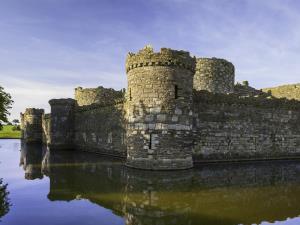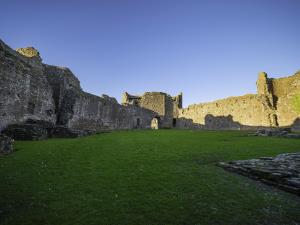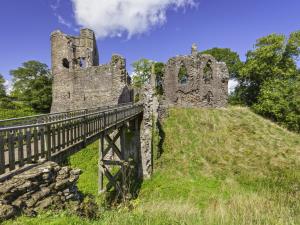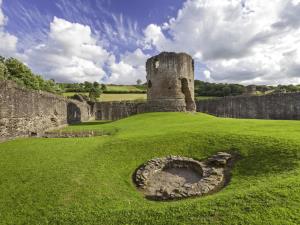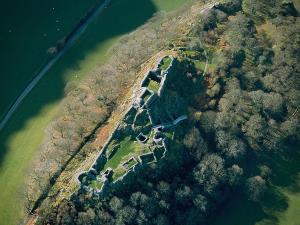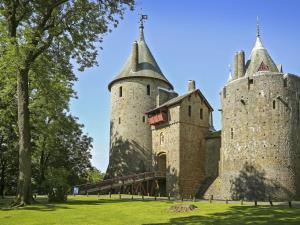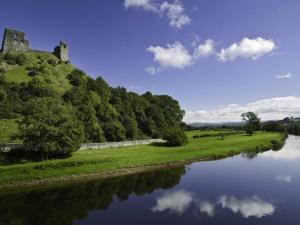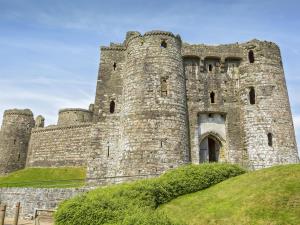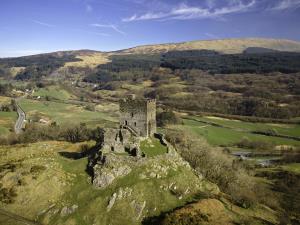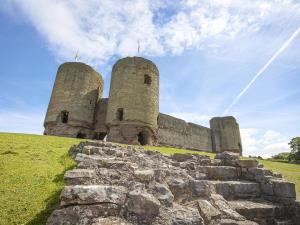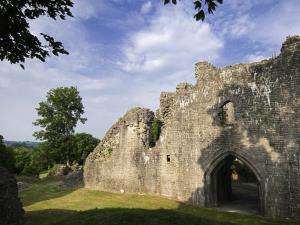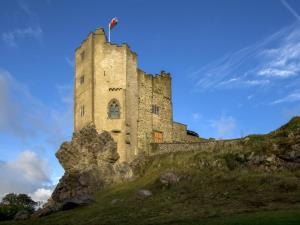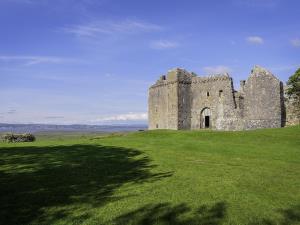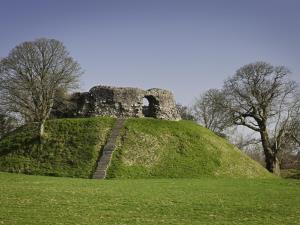Most first-time visitors make a beeline for our big 'n' famous castles. And that’s fair enough - they’re great. But if you head off the beaten track, there are hundreds more out there, often in the prettiest places, and usually with hardly anyone else there. Here are some gems where you can be king or queen of the castle.
Castell Biwmares (Beaumaris Castle), Anglesey, North Wales
In a land full of castles notable for their decayed, imperfect beauty, the wonderfully incomplete Castell Biwmares (Beaumaris Castle) is widely considered the most technically accomplished castle in Britain, yet also the greatest castle never built. The largest and last of the castles created by Edward I in Wales, it has near-perfect symmetry, four concentric rings of formidable defences and a water-filled moat with its own dock. Overhead photos always make it look like a study in symmetry, so get up close and admire the king’s grandiose vision.
Along with Conwy, Caernarfon and Beaumaris, it forms part of the Castles and Town Walls of King Edward UNESCO World Heritage Site.


Y Castell Gwyn (White Castle), Monmouthshire, South Wales
Named after its original white-rendered walls, Y Castell Gwyn (White Castle) is one of three fortresses - Grosmont and Skenfrith are the others - built by Norman lords in the Monnow Valley to guard the borderlands. Although it was already derelict by the 1600s, White Castle is easily the best preserved of the trio – with the bonus of a rural Monmouthshire setting.


Castell Ynysgynwraidd (Skenfrith Castle), Monmouthshire, South Wales
Time travel fans need to visit Castell Ynysgynwraidd (Skenfrith Castle) – the Norman castle once played host to an episode of Doctor Who. See why this circular keep, constructed in the Monnow Valley as one of three neighbouring castles resulting from the Norman conquest of South Wales, is a repeated favourite of television crews.


Castell y Bere, Eryri (Snowdonia), North Wales
Built by Llywelyn the Great in the 1220s, Castell y Bere was conquered by the Normans in 1283 and swiftly abandoned: Edward I didn’t think its location was of great strategic importance. But that’s what makes it so magical today: the ruins sit in a quietly beautiful valley in southern Eryri (Snowdonia). Sometimes it’s not about the size of the towers – it’s about the majesty of the place itself.

Castell Coch, Cardiff, South Wales
Castell Coch is a castle on top of a castle. It was originally a chieftain’s fortress in the 13th century, but underneath the mock-medieval trappings you can still trace the impressive remains of a 13th-century castle, once used as a hunting lodge by the ruthless Marcher lord Gilbert de Clare and resurrected as a gothic fortress several centuries later. It is now notable for it's highly decorated interiors and rich furnishings, make it a dazzling masterpiece of the High Victorian era and a repeated favourite with visitors and film and television crews alike.



Nevern Castle, Pembrokeshire, West Wales
There’s hardly anything left of Nevern, one of Wales’ oldest stone-built castles: the stumps of a few towers, and defensive earthworks which blend into the wooded crags and gorges that surround the site. But the beauty of the location makes it a lovely place to visit, especially combined with a visit to the exquisite village church.
Castell Dryslwyn (Dryslwyn Castle), Carmarthenshire, West Wales
Built in the 1220s by the princes of Deheubarth, Dryslwyn proves that native Welsh princes were just as adept at knocking up a mighty fortress as the invading Normans. The remains look a bit scant from down below, but when you climb the hill, an entire medieval town layout reveals itself, as well as panoramic views of the Tywi Valley.

Kidwelly Castle, Carmarthenshire, West Wales
Kidwelly has everything a castle should: steep earthworks, high towers, tall walls and a great gatehouse that took at least a century to complete. Peel back the centuries to the earliest earth-and-timber castle built by the Normans. You can trace its half-moon shape by walking along the stone walls built almost 100 years later.
This Norman stronghold changed hands several times during the battles between the Welsh and the invaders, so it’s remarkable that the castle has survived so completely. During one attack, the heroic Princess Gwenllian was caught and beheaded by Normans in 1136; it's rumoured that her headless ghost still haunts the town. The castle also provided the opening backdrop for the film Monty Python and the Holy Grail. Don't leave without exploring the great gatehouse or the beautiful little chapel overlooking the river.


Castell Dolwyddelan (Dolwyddelan Castle), Conwy, North Wales
Native Welsh castles always seem to be in the prettiest places (the Normans were more boringly pragmatic). The square tower looks gorgeous on its rocky plinth, overlooking the site of an earlier castle, Tomen Castell. Edward I garrisoned troops at Dolwyddelan, issuing them with white uniforms for winter warfare.


Castell Rhuddlan (Rhuddlan Castle), Denbighshire, North Wales
Rhuddlan sat at the lowest crossing-point of the River Clwyd, which made it a natural frontier – and battleground – between the Welsh and invaders for 600 years before Edward I arrived in 1277. This is the first castle designed by James of St George, his master builder, who went on to build a string of thumping great fortresses along the North Wales coast. At Castell Rhuddlan (Rhuddlan Castle) you can see the genesis of his concentric ‘walls within walls’ design.

St Quentin's Castle, Llanblethian, South Wales
Before his death at the 1314 Battle of Bannockburn, Gilbert de Clare designed a castle he never got to complete. Every inch of the crumbled, jagged St Quentin's Castle grabs the imagination with its enormous twin-towered gatehouse, designed to give extra defence on the weaker side of the four surrounding slopes.


Roch Castle, Pembrokeshire, West Wales
Norman and Flemish invaders built a series of fortresses along the ‘Landsker Line’, an otherwise invisible frontier between the Welsh-speaking north and Anglophone south of Pembrokeshire that still exists today.
Roch Castle was built in the 1190s, badly damaged during the Civil War in the 1640s, and a complete ruin by the 1800s. In the early 1900s Roch was painstakingly restored by the Viscount St Davids, and now runs as a luxury hotel.


Weobley Castle, Gower, West Wales
It’s more of a fortified manor than an all-out castle, but Weobley Castle is worth visiting for a couple of reasons. For a start, the views over the northern coast of Gower are sublime, and the marshes are grazed by flocks of sheep that provide delicious salt marsh lamb – available from the adjoining farm’s shop.

Castell Cas-wis (Wiston Castle), Pembrokeshire, West Wales
Built by the splendidly-named 12th century Flemish knight Wizo, Castell Cas-wis (Wiston Castle) is one of the finest examples of a motte and bailey castle you’ll see: its motte (mound) is still capped by a hefty stone tower. The castle fell repeatedly to the Welsh, and it was put permanently out of action by Llewelyn the Great in 1220.



